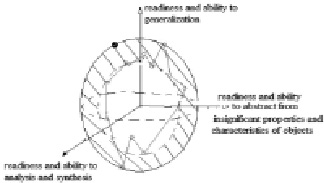To approbate suggested mathematical competence functional model, the e-learning process results of mathematical competence components development for clinical psychology faculty students were considered. According to research results, 90 % of medical students got enough mathematical base for studying the other medical school disciplines, knowledge in math for solving professional activity tasks, high level development in each mathematical competence component to solve practical and theoretical problems. Thus, the suggested model allowed us to esteem the mathematics e-learning effectiveness in formation and development of students’ mathematical competence as high.
The successful mathematical tasks solving requires three cognitive components possession: readiness and ability to analysis and synthesis; readiness and ability to abstract from insignificant properties and characteristics of objects; readiness and ability to generalization [3, 5, 6]. The mathematical competence model in three-dimensional space, based on main structural components, is easily realized in educational process to show real university students’ mathematical competence development level and its separate components, providing studies of various factors influence on process of mathematical competence formation [1, 2, 4].
The approbation of functional components mathematical competence model in medical school e-learning efficiency studying is our research aim. Medical university clinical psychology students’ mathematical competence was chosen as the research object. Materials and methods. The testing of second-year clinical psychology students was carried out. 10 second-year clinical psychology faculty students were involved into mathematical e-learning testing after passing the mathematical course examination. The research was held at 11 a.m. in the academic auditory. The research duration was about 50 minutes. The clinical psychology faculty students performed the testing independently without using any electronic devices. The testing was built on the basis of Atmhauer intelligence structure test including the scale of mathematical abilities determination and a questionnaire “Thinking type”.
Results. To approbate suggested mathematical competence functional model, we consider e-learning process results of mathematical competence components development for clinical psychology faculty students. For this purpose we will take 100-grade scale for each mathematical competence structural component. The research results of clinical psychology faculty students’ mathematical competence components development in e-learning process are represented in the table.
We build three-dimensional mathematical competence model based on the received results. Provided that K1max = K2max = K3 max = 100, sphere external radius Rexternal is calculated as:
 (1)
(1)
The magnitude of sphere internal radius Rinternal is found from expression:
Rinternal = 0,6 Rexternal = 103. (2)
The distance between internal and external radii can be calculated from the following formula:
d = 173 – 103 = 70. (3)
Clinical psychology faculty students’ mathematical competence components development in e-learning process
|
№ p/p |
Main structural components of mathematical competence |
||
|
К1 – ability to analysis and synthesis |
К2 – ability to abstraction from objects’ insignificant properties and characteristics |
К3 – ability to generalization |
|
|
1 |
90 |
100 |
60 |
|
2 |
40 |
95 |
50 |
|
3 |
50 |
85 |
40 |
|
4 |
65 |
85 |
60 |
|
5 |
40 |
75 |
50 |
|
6 |
60 |
85 |
50 |
|
7 |
70 |
60 |
70 |
|
8 |
85 |
100 |
30 |
|
9 |
80 |
65 |
30 |
|
10 |
60 |
90 |
100 |

Mathematical competence model for clinical psychology faculty students. Note: the area designated by shading on the sphere designates the level of mathematical competence of pupils conforming to requirements of the federal state educational standard
This distance points medical school students’ mathematical competence level corresponding to educational standard. The build mathematical competence model for clinical psychology faculty students is shown on figure.
From the figure, nine of ten points, indicating students’ mathematical competence level, are located at the area of sphere shell. It means, that e-learning in 90 % cases results to students’ mathematical competence level corresponding to educational standard. These students, as the result of e-learning, got enough mathematical base for studying the other medical school disciplines, knowledge in math for solving professional activity tasks, high level development in each mathematical competence component to solve practical and theoretical problems. And only one point, indicated students’ mathematical competence level, is located out of the sphere shell. It means, that for 10 % of all students insufficient mathematical competence level was formed. That level is not corresponding to educational standard level. Two mathematical competence components from three were revealed. Thus, the suggested model allowed us to make the conclusion about medical school students’ mathematical competence level, to esteem the mathematics e-learning effectiveness in formation and development of students’ mathematical competence as high, to diagnose each mathematical competence component separately and all integrative characteristic in general. The model can be used to evaluate the mathematical competence development dynamics, to assess each mathematical competence component separately, to invent the effective mathematics teaching strategy.
The work is submitted to the International Scientific Conference “Higher professional education. Modern aspects of the international cooperation ”, Israel (tel Aviv), Feb 20–27, 2017, came to the editorial office оn 07.12.2016.
Библиографическая ссылка
Snegireva L.V. THE APPROBATION OF MATHEMATICAL COMPETENCE MODEL IN MEDICAL SCHOOL E-LEARNING EFFICIENCY STUDYING // European Journal of Natural History. 2017. № 3. С. 66-68;URL: https://world-science.ru/ru/article/view?id=33746 (дата обращения: 05.12.2025).

